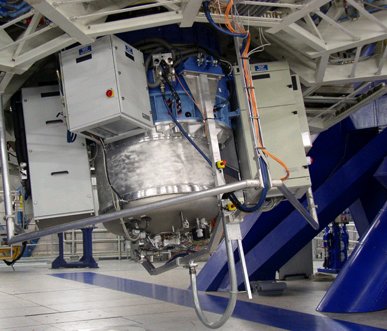SINFONI - Spectrograph for INtegral Field Observations in the Near Infrared
Summary
 SINFONI is a near-infrared (1.1 -- 2.45 µm) integral field spectrograph fed by an adaptive optics module, currently installed at the Cassegrain focus of UT3. The spectrograph operates with 4 gratings (J, H, K, H+K), providing a spectral resolution around 2000, 3000, 4000 in J, H & K respectively, and 1500 in H+K -- each wavelength band fitting fully on the 2048 pixels of the Hawaii 2RG (2kx2k) detector in the dispersion direction. The spatial "pixel" scale is selectable from 0.25", 0.1" to 0.025" per image slice, corresponding to field-of-views of 8"x8", 3"x3" and 0.8"x0.8" respectively. The instrument can be used with a Natural Guide Star or a Laser Guide Star to provide near diffraction-limited observations. It can also be used for seeing-limited open-loop observations.
SINFONI is a near-infrared (1.1 -- 2.45 µm) integral field spectrograph fed by an adaptive optics module, currently installed at the Cassegrain focus of UT3. The spectrograph operates with 4 gratings (J, H, K, H+K), providing a spectral resolution around 2000, 3000, 4000 in J, H & K respectively, and 1500 in H+K -- each wavelength band fitting fully on the 2048 pixels of the Hawaii 2RG (2kx2k) detector in the dispersion direction. The spatial "pixel" scale is selectable from 0.25", 0.1" to 0.025" per image slice, corresponding to field-of-views of 8"x8", 3"x3" and 0.8"x0.8" respectively. The instrument can be used with a Natural Guide Star or a Laser Guide Star to provide near diffraction-limited observations. It can also be used for seeing-limited open-loop observations.
Publications based on data obtained with the SINFONI instrument should quote the following reference papers: Eisenhauer, F. et al. 2003, SPIE 4841, 1548 and Bonnet, H. et al. 2004, The ESO Messenger 117, 17.
Contact Information
- Questions related to service mode observations and proposal preparation should be addressed to the User Support Department.
- Questions related to visitor mode observations should be addressed to Paranal Science Operations
- Please send us your comments, suggestions and report errors and inaccurate statements in the web pages and manuals.
Content of these pages
The following items are available on all the SINFONI pages, using the bar on the left.
- Overview: a short description of the instrument
- News: list of changes affecting the instrument and/or its pages.
- Instrument Description: all the important parameters of the instrument.
- Manuals: links to all the documents related to SINFONI.
- Tools: a collection of useful tools and informations for preparing and analyzing the SINFONI observations.
- Instrument Operations Team
- Visitor Instructions: Instrument specific instructions for Visiting Astronomers
